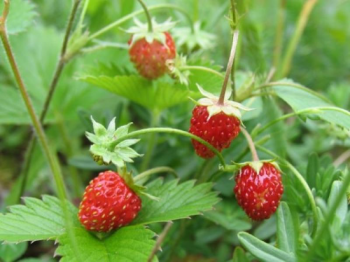Woodland Strawberry (Fragaria vesca)
Common Name(s): Woodland strawberry
Scientific Name(s): Fragaria vesca
Island Hulkemel’em Name(s): sciy'u (fruit) – No specific word, due to the fact that the vesca species was introduced from Europe.
Family: Vesca
Cautions: None
Botanical Description: The woodland strawberry is a perennial herb that produces edible fruit. Woodland strawberry leaflets tend to be yellowish green. The white flowers of the species are about 2-3 cm across and perched atop a flexible hairy stem. Woodland strawberry shrubs raise their flowers above the leaves. It inhabits open forests, clearings, fields and meadows. The woodland strawberry grows naturally throughout much of the Northern Hemisphere.[1]
Current Distribution and Local Habitat(s): Woodland strawberry shrubs occur wild throughout the temperate Northern Hemisphere, in Europe, Asia, North America, and temperate parts of South America (Chile). The woodland strawberry's habitat ranges from sandy fields to clearings and meadows. It is common along the coastline from Alaska to California.[2]
Ethnobotanical Application(s): Wild strains of woodland strawberry have been grown in European gardens for centuries. Known as “fraise des bois” or alpine strawberries. It was widely cultivated throughout Europe until the 18th century when it began to be replaced by the garden strawberry, which has much larger fruit. However, woodland strawberry fruit has a strong flavour and is still collected and grown for domestic uses and on small scales for use in gourmets and as an ingredient for jam, sauces, and liqueurs.[3] Many groups of First Nations knew and enjoyed wild strawberries, before the introduction of woodland strawberry to the Pacific West coast by European settlers. Woodland strawberries are still consumed and used by many First Nations. Mostly, people would simply eat the fruits wild off the plant, though sometimes the fruits are mixed and dried with other berries. In some areas, the leaves of the woodland strawberry are harvested and mixed with those of thimbleberry (Rubus parviflorus) and other plants to be steeped into a sweet tea. Anti-diarrhea medicines for children are made from the leaves. Woodland strawberries make excellent jam and getting them is always a fun event for people of all ages.[4]
Strawberry and Salmonberry Jam Recipe:
- Woodland Strawberries
- Salmonberries (optional)
- pectin (optional)
- sugar
Rinse off the salmonberries and strawberries and remove any stems, leaves, or mouldy pieces. Measure out 2/3 cup of sugar for every 1 cup of berries. Use a potato masher to crush the berries. Heat the berries and sugar on medium and stir constantly until the sugar dissolves. Heat the jam on high to achieve a boil while continuing to stir. Boil until the jam sheets off of a spoon or saucer. If the jam seems too watery, or if you lose patience, add a tablespoon of pectin. If foam forms, skim it off the top. Spoon the hot jam into the sterilised jars leaving ¼ inch space. Tighten the lids down with the bands and boil the jars in water for 10 minutes. Cool the jars on the counter overnight and check the seals in the morning.
UVic Campus Location(s): The woodland strawberries can be found behind and to the side of the Hickman building, in the Garry Oak Meadow, the UVic Native Plant Garden and at the side of the path between the Sedgewick and the David Turpin building.
Figure Reference(s):
Figure 1: https://images.sciencedaily.com/2010/12/101226131607_1_900x600.jpg
Figure 2: http://linnet.geog.ubc.ca/
[1] Plants Profile for Fragaria vesca (woodland strawberry). Accessed September 09, 2016. https://plants.usda.gov/core/profile?symbol=FRVE.
[2] Plant Finder. Fragaria vesca. http://www.missouribotanicalgarden.org/PlantFinder/PlantFinderDetails.aspx?kempercode=b346.
[3] Lloyd, T. A., & Chambers, F. H. (2014). Wild berries of Washington and Oregon. Lone Pine.
[4] Turner, Nancy J., Laurence C. Thompson and M. Terry Thompson et al. 1990. Thompson Ethnobotany: Knowledge and Usage of Plants by the Thompson Indians of British Columbia, Victoria. Royal British Columbia Museum, page 259
Project Status:
Date Completed:
Year:
Associated Projects:
Image:

